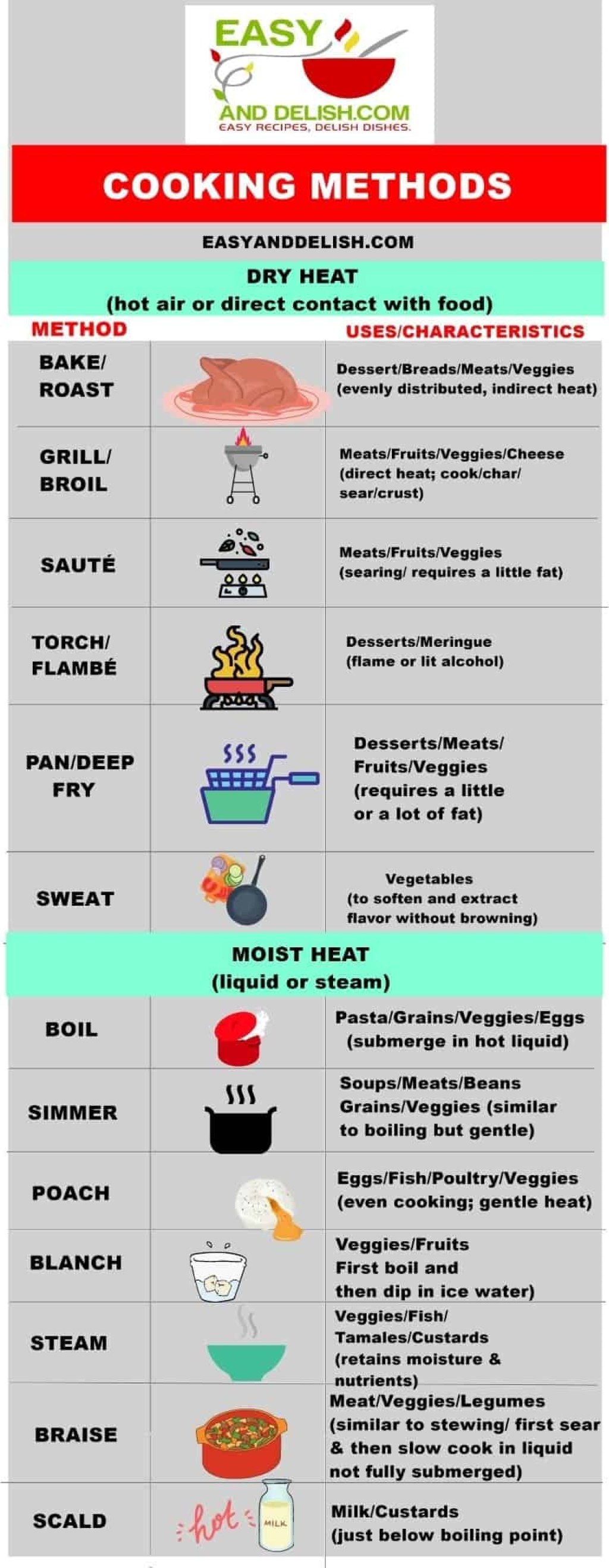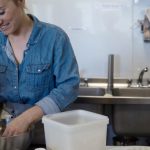Master The Art Of Cooking Methods Heating: Unlock The Secrets To Perfectly Cooked Dishes!
Cooking Methods Heating: A Comprehensive Guide to Mastering the Art
Introduction
Dear Readers,
1 Picture Gallery: Master The Art Of Cooking Methods Heating: Unlock The Secrets To Perfectly Cooked Dishes!

Welcome to our comprehensive guide on cooking methods heating. Whether you are a novice or an experienced cook, understanding the various cooking techniques and how heat is applied can greatly enhance your culinary skills. In this article, we will delve into the science behind cooking methods heating, explore their advantages and disadvantages, and provide practical tips to help you become a master in the kitchen.
What is Cooking Methods Heating?

Image Source: easyanddelish.com
🔥 Cooking methods heating refers to the various techniques used to apply heat to food in order to transform its flavor, texture, and appearance. It involves the use of heat sources such as stovetops, ovens, grills, and microwaves to cook ingredients and create delicious meals.
Who Uses Cooking Methods Heating?
👨🍳 Cooking methods heating is utilized by professional chefs, home cooks, and anyone who enjoys preparing meals. It is a fundamental skill in the culinary world and is essential for creating a wide range of dishes, from simple everyday meals to gourmet delicacies.
When to Use Cooking Methods Heating?
⏰ Cooking methods heating is used whenever you need to cook or prepare food. Whether it’s breakfast, lunch, dinner, or even snacks, understanding the appropriate cooking methods and heating techniques ensures that your food is cooked to perfection.
Where Can You Apply Cooking Methods Heating?
🍳 Cooking methods heating can be applied in various settings, including professional kitchens, home kitchens, outdoor grilling areas, and even camping sites. The versatility of cooking methods heating allows you to prepare meals in any location with the right equipment.
Why is Cooking Methods Heating Important?
🌟 Cooking methods heating is important because it directly affects the taste, texture, and appearance of food. By mastering different heating techniques, you can unlock a world of flavors and create dishes that are visually appealing. Furthermore, understanding cooking methods heating ensures that your food is cooked safely and thoroughly, reducing the risk of foodborne illnesses.
How Does Cooking Methods Heating Work?
🔬 Cooking methods heating works by transferring heat energy from a heat source to the food. Heat can be transferred through conduction, convection, or radiation. Conduction occurs when heat is transferred directly from one surface to another, such as when food is placed on a hot pan. Convection involves the circulation of heat through a medium, such as hot air in an oven. Radiation occurs when heat is transferred through electromagnetic waves, such as in a microwave.
Advantages of Cooking Methods Heating
✅ Cooking methods heating offers several advantages:
Enhances flavors and textures
Cooks food evenly
Allows for precise temperature control
Creates appealing visual presentations
Offers versatility in cooking techniques
Let’s explore each advantage in detail:
Enhances flavors and textures
👅 Cooking methods heating brings out the natural flavors in ingredients and enhances their textures. By applying heat, the Maillard reaction occurs, resulting in the browning and caramelization of proteins and sugars, which adds depth and complexity to the taste of the food.
Cooks food evenly
🍳 Cooking methods heating ensures that food is cooked evenly, preventing undercooking or overcooking. This is particularly important when cooking ingredients that require precise cooking times and temperatures, such as meats, fish, and delicate desserts.
Allows for precise temperature control
🌡️ Cooking methods heating allows you to control the temperature at which your food is cooked. This is essential for achieving the desired results, whether it’s searing a steak at high heat or simmering a delicate sauce at low heat.
Creates appealing visual presentations
👁️🗨️ Cooking methods heating enables you to create visually appealing dishes by adding color, texture, and contrast. From golden-brown crusts to vibrant vegetable stir-fries, the visual presentation of food plays a crucial role in the overall dining experience.
Offers versatility in cooking techniques
🍴 Cooking methods heating encompasses a wide range of techniques, such as sautéing, grilling, roasting, baking, steaming, and more. This versatility allows you to explore different flavors, textures, and cooking styles, keeping your meals exciting and varied.
Disadvantages of Cooking Methods Heating
❌ Cooking methods heating also has its disadvantages:
Loss of nutrients
Can be time-consuming
Requires proper ventilation
Potential for accidents or injuries
May result in the formation of harmful compounds
Let’s take a closer look at each disadvantage:
Loss of nutrients
🌾 Some cooking methods heating, such as boiling or long-duration cooking, can lead to the loss of certain nutrients in food, particularly water-soluble vitamins. To minimize nutrient loss, it is advisable to cook food for shorter durations and use cooking methods that retain more nutrients, such as steaming or stir-frying.
Can be time-consuming
⌛ Cooking methods heating can be time-consuming, especially when preparing dishes that require extended cooking times or intricate techniques. This can pose a challenge when you have limited time for meal preparation or need to serve meals quickly.
Requires proper ventilation
🌬️ Some cooking methods, such as grilling or frying, produce smoke, odors, or steam that require proper ventilation to maintain air quality in the kitchen. Inadequate ventilation can lead to the accumulation of unpleasant odors or even trigger respiratory issues for individuals with sensitivities.
Potential for accidents or injuries
⚠️ Cooking methods heating involves working with hot surfaces, flames, and boiling liquids, which can increase the risk of accidents or injuries. It is important to exercise caution, use appropriate protective equipment, and follow safety guidelines to minimize the risk of burns, cuts, or other mishaps in the kitchen.
May result in the formation of harmful compounds
⚠️ Certain cooking methods heating, such as grilling or frying at high temperatures, can lead to the formation of potentially harmful compounds, such as acrylamide or polycyclic aromatic hydrocarbons (PAHs). These compounds have been associated with health risks when consumed in large amounts. It is advisable to moderate the consumption of foods cooked using these methods and incorporate a variety of cooking techniques into your meal preparation.
Frequently Asked Questions (FAQs)
1. Can I use a microwave for all cooking methods heating?
🔍 While microwaves are convenient for reheating leftovers or quickly cooking certain foods, they may not be suitable for all cooking methods heating. Microwaves primarily use radiation to heat food, which may not provide the same results as other cooking techniques that involve conduction or convection. It is best to use a combination of cooking methods heating to achieve the desired outcomes.
2. What is the best cooking method for preserving nutrients?
🔍 Steaming is often considered one of the best cooking methods for preserving nutrients. Since steaming involves cooking food with steam, it helps retain water-soluble vitamins and minerals that may be lost through other cooking methods. Steamed vegetables, for example, retain their vibrant colors, crisp textures, and nutritional value.
3. How can I avoid overcooking meat when grilling?
🔍 To avoid overcooking meat when grilling, it is crucial to monitor the internal temperature using a meat thermometer. Each type of meat has specific recommended internal temperatures for different levels of doneness. By using a thermometer, you can ensure that your meat is cooked to perfection without drying it out.
4. Are there any cooking methods heating that require minimal oil?
🔍 Yes, there are cooking methods heating that require minimal oil. Techniques such as baking, steaming, or poaching do not necessarily require the use of oil. These methods allow you to cook food using the moisture present in the ingredients or by adding a small amount of liquid, such as broth or water.
5. Can I combine different cooking methods heating in one dish?
🔍 Absolutely! Combining different cooking methods heating in one dish can add complexity and depth of flavor. For example, you can sear a steak on a hot pan to develop a crust and then finish cooking it in the oven. Experimenting with various cooking methods heating can result in delicious and unique dishes.
Conclusion
📝 Cooking methods heating is a fundamental skill for anyone who wants to excel in the kitchen. By understanding the different techniques and how heat is applied, you can elevate your cooking to new heights. Remember to experiment, practice, and always prioritize safety. So, grab your apron, turn up the heat, and embark on a culinary adventure like no other!
Happy cooking!
Final Remarks
Disclaimer: The information provided in this article is for educational purposes only. It is not intended as a substitute for professional advice or guidance. Always exercise caution and follow proper cooking techniques and safety guidelines when using cooking methods heating. The authors and publishers of this article are not liable for any damages or injuries that may occur as a result of applying the information presented herein.
This post topic: Cooking Techniques

